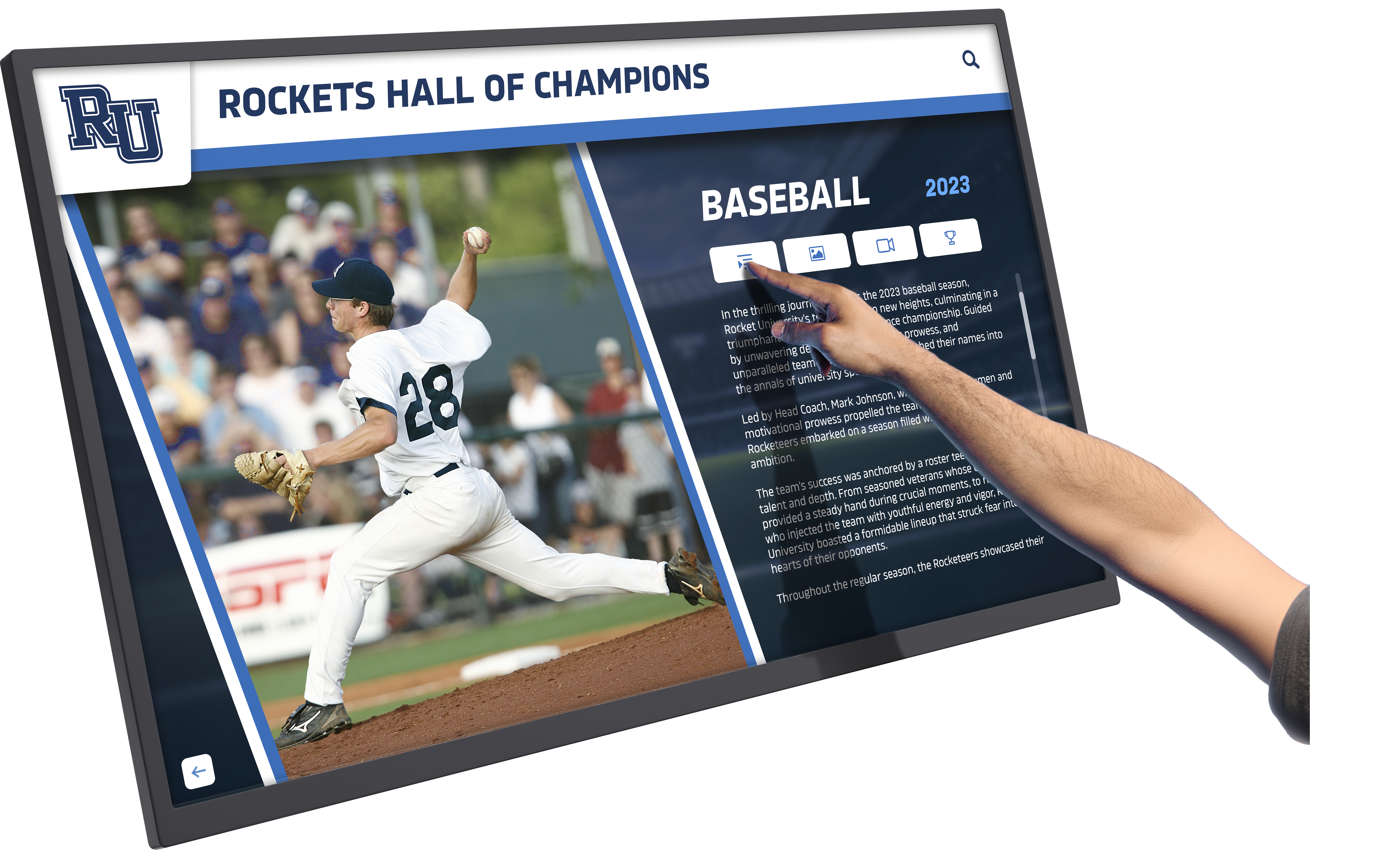Key Takeaways
Discover how high schools can build and showcase comprehensive alumni networks featuring professional athletes, medical professionals, CEOs, and business leaders through modern digital recognition systems.
Why Distinguished Alumni Networks Matter for High Schools
Distinguished alumni networks represent far more than simple name lists or bragging rights—they serve as powerful educational tools that deliver measurable benefits across multiple school priorities including student inspiration and career exploration, community pride and institutional reputation, fundraising and philanthropic engagement, recruiting advantage for competitive programs, and historical preservation and legacy documentation.
The Inspiration Factor: Role Models Matter
When current students see graduates from their school achieving remarkable success across diverse fields, possibilities become tangible rather than abstract. A student interested in medicine discovers an alumnus who became a leading cardiac surgeon. An aspiring entrepreneur finds a graduate who founded a successful technology company. An athlete sees former players competing professionally in their sport.
Research in educational psychology consistently demonstrates that accessible role models significantly impact student motivation and achievement. Students who can identify with successful individuals who walked the same hallways, sat in the same classrooms, and faced similar challenges develop stronger self-efficacy beliefs and higher aspiration levels.
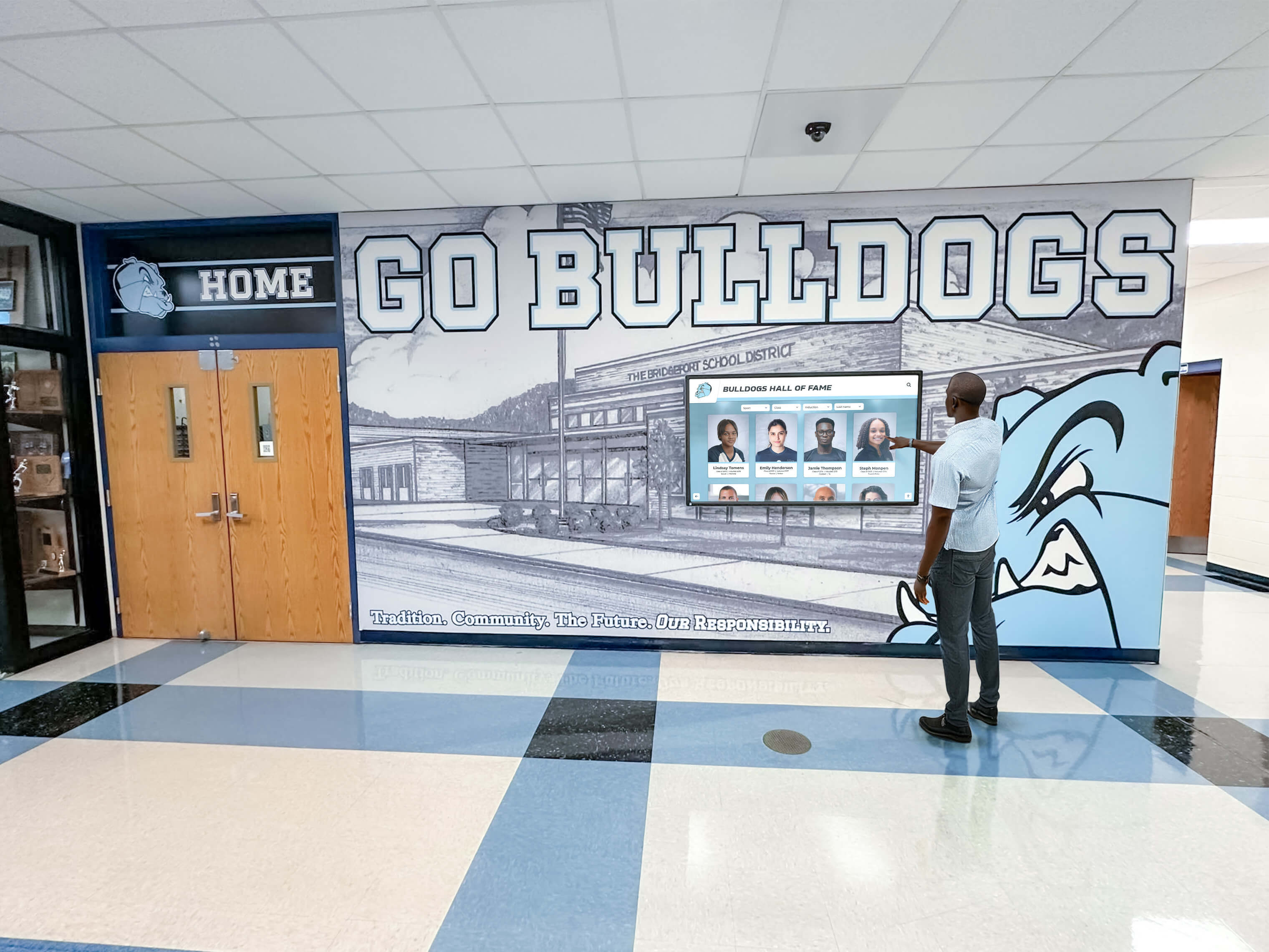
Diverse Achievement Pathways: Comprehensive alumni networks showcase that success takes many forms. Not every graduate becomes a professional athlete or Fortune 500 CEO—and that’s exactly the point. When schools celebrate diverse achievements including educators shaping future generations, community leaders serving their neighborhoods, skilled tradespeople building successful businesses, artists and creatives pursuing their passions, and public servants contributing to society, students with varied interests and aptitudes see themselves reflected in graduate success stories.
Community Pride and Institutional Reputation
Distinguished alumni serve as tangible evidence of educational quality and institutional impact. When communities can point to impressive graduate achievements—the NFL player who started in your school’s athletic program, the medical researcher who got their foundation in your science classes, the business leader who developed their skills in your school—pride in the institution grows exponentially.
This pride translates into concrete benefits through increased community support for school initiatives, enhanced property values in school districts with strong reputations, greater family willingness to volunteer and contribute, improved teacher recruitment as educators want to work at schools with strong cultures, and positive media coverage highlighting graduate achievements that reflect well on the institution.
Categories of Distinguished Alumni to Recognize
Comprehensive alumni networks celebrate achievement across multiple dimensions rather than focusing narrowly on a single category. Effective recognition systems include diverse categories that represent your graduate community’s full spectrum of success.
Professional Athletes and Sports Excellence
Athletic achievement represents one of the most visible and celebrated forms of alumni success. High schools across the country have produced professional athletes competing at the highest levels across nearly every sport.
Professional Sports Recognition Should Include:
- Professional league athletes (NFL, NBA, MLB, NHL, MLS, WNBA, NWSL)
- Olympic and international competition participants
- Professional athletes in individual sports (golf, tennis, MMA, boxing)
- College scholarship athletes at Division I, II, and III programs
- All-American selections and major collegiate award recipients
- Professional coaches and sports management professionals
Athletic recognition extends beyond just listing names and current teams. Comprehensive profiles should document career statistics and major accomplishments, memorable high school performances and records, the journey from high school to professional level, community involvement and charitable work, and advice for current student-athletes pursuing similar paths.
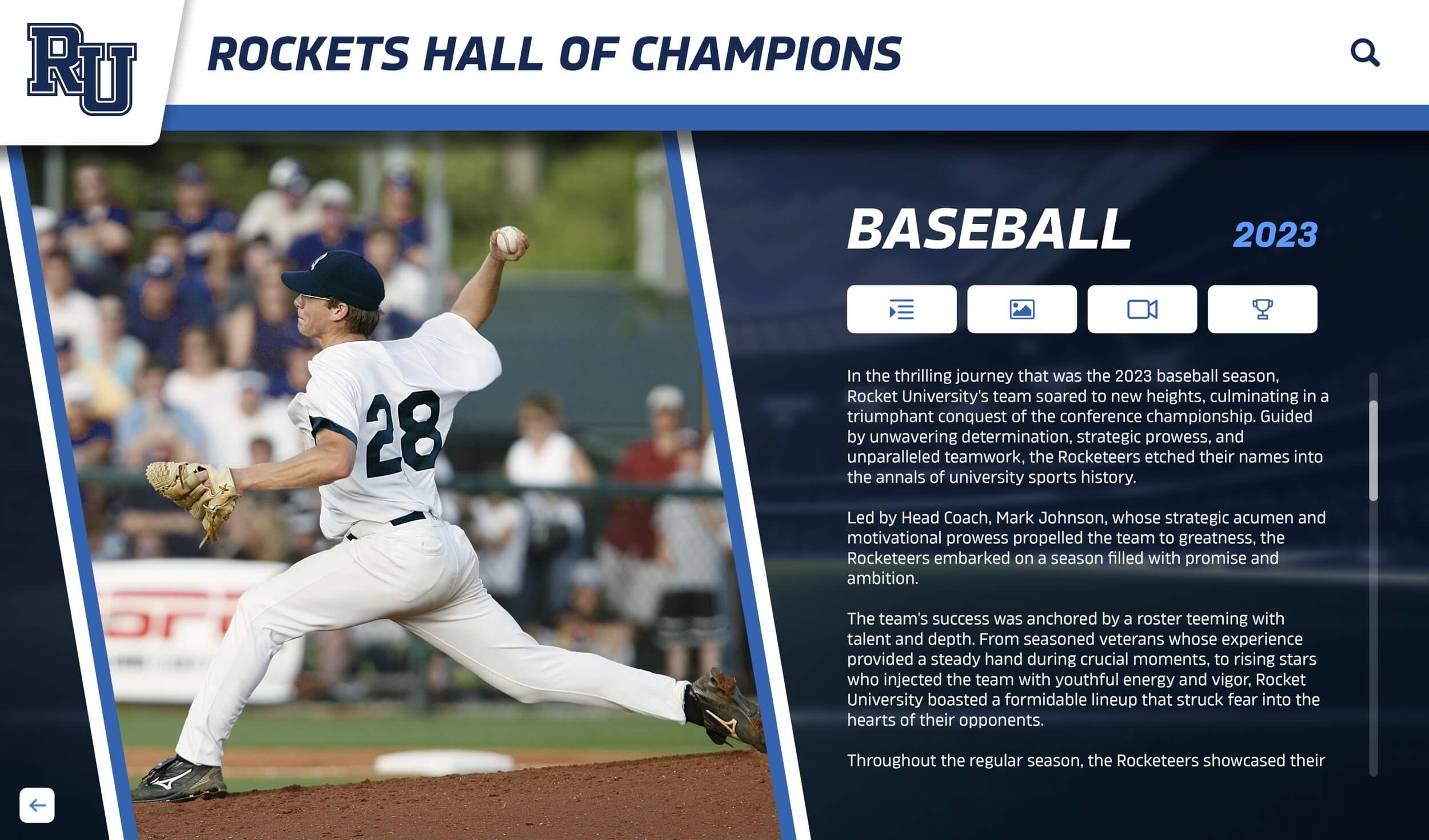
Many schools partner with solutions like Rocket Alumni Solutions to create interactive digital displays that showcase athletic alumni with multimedia content including game highlights, career statistics, and personal messages to current students.
Business Leaders and Entrepreneurs
Business success takes countless forms, from Fortune 500 executives to local business owners who create jobs and contribute to their communities. Recognizing business achievement demonstrates that your school develops graduates prepared for economic leadership.
Business Alumni Recognition Categories:
Corporate Leadership: CEOs, presidents, and C-suite executives of major corporations; board members and directors of publicly traded companies; senior management at Fortune 500 and emerging growth companies; industry pioneers and business innovators.
Entrepreneurship: Founders of successful startups and technology companies; small business owners who built thriving enterprises; social entrepreneurs addressing community challenges; serial entrepreneurs with multiple successful ventures.
Professional Services: Partners at major law firms and accounting firms; financial services leaders and investment professionals; consultants and advisory firm principals; real estate development and commercial property leaders.
Effective business leader recognition goes beyond titles and positions to include the impact they’ve created through jobs created and economic contributions, innovations and industry advancements, philanthropic giving and community support, mentorship of current students and young professionals, and the connection between their high school foundation and later success.
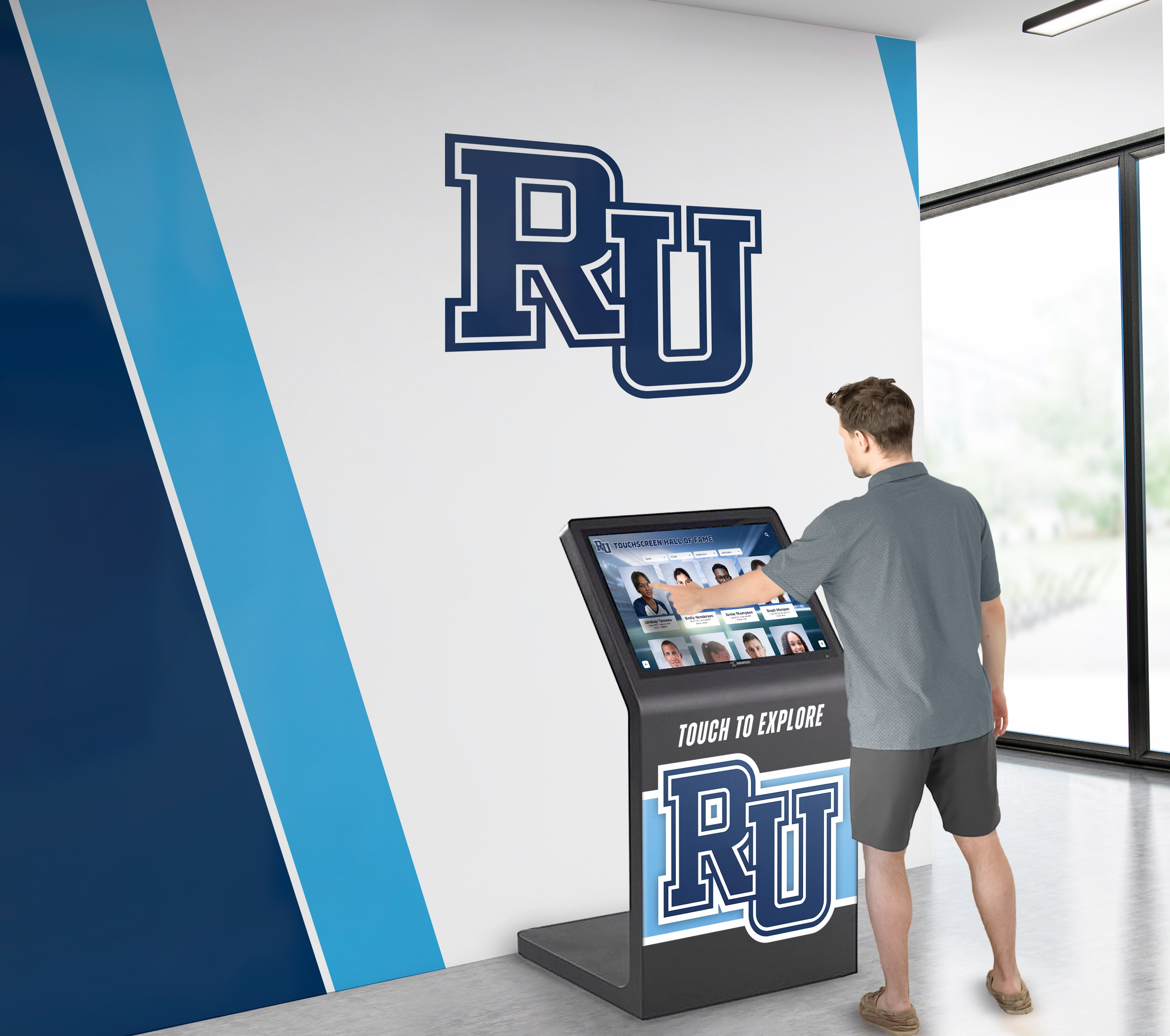
Medical Professionals and Healthcare Leaders
Healthcare professionals represent some of the most impactful careers graduates pursue, directly affecting community health and wellbeing. Medical professional recognition celebrates both clinical excellence and healthcare leadership.
Healthcare Alumni Recognition Should Include:
- Physicians across all specialties and practice settings
- Surgeons and specialists with distinguished practices
- Researchers advancing medical knowledge and treatments
- Nurses and advanced practice providers
- Healthcare administrators and hospital executives
- Public health leaders and policy experts
- Medical educators training future healthcare professionals
- Healthcare entrepreneurs and innovation leaders
Medical professional profiles should emphasize their specialty areas and practice locations, research contributions and published work, awards and professional recognition received, community health initiatives and volunteer work, the path from high school through medical education, and advice for students interested in healthcare careers.
For schools with significant healthcare alumni populations, consider implementing digital recognition displays that can accommodate comprehensive alumni databases with detailed career information and multimedia profiles.
Academic Leaders and Educators
Graduates who become educators themselves represent full-circle success stories—students who valued their education enough to dedicate their careers to educating others. Academic leadership recognition celebrates those shaping minds and advancing knowledge.
Academic Achievement Recognition:
Higher Education Leaders: University presidents and provosts; deans and department chairs; distinguished professors and endowed chairs; leading researchers and scholars.
K-12 Educational Leaders: Superintendents and district administrators; principals and school leaders; master teachers and curriculum specialists; education policy advocates and reformers.
Educational Innovation: EdTech entrepreneurs and innovators; instructional designers and educational consultants; authors of influential educational texts and resources; online education pioneers and thought leaders.
Academic recognition demonstrates your school’s commitment to education as a profession and honors graduates who chose to give back through teaching. Understanding academic recognition best practices helps schools create compelling profiles that inspire students considering education careers.
Building Your Distinguished Alumni Database
Creating a comprehensive alumni database requires systematic approaches to identify, research, and document graduate achievements across decades of graduating classes.
Initial Research and Discovery
Most schools possess more distinguished alumni than they realize. Discovery requires multiple research approaches to identify graduates who achieved notable success in various fields.
Alumni Association Records
Start with existing alumni association databases, membership directories, and reunion attendance records that often contain career information
Social Media Research
LinkedIn, Facebook, and Twitter provide rich sources of alumni career information and professional accomplishments
Media Monitoring
Set up Google Alerts for your school name to discover when alumni are mentioned in news articles or professional publications
Yearbook Mining
Historical yearbooks provide graduating class lists that can be cross-referenced with professional databases and search engines
Professional Database Searches: For specific professions, utilize industry-specific databases and directories. Professional sports leagues maintain comprehensive rosters and historical player databases. Medical professionals can be located through state medical board directories and hospital staff listings. Business leaders appear in company websites, LinkedIn, and business publication databases. Legal professionals are listed in bar association directories. Academic leaders are documented in university faculty and administrative directories.
Community Outreach and Nominations: Engage your broader school community in identifying distinguished alumni through nomination forms on school websites and social media, outreach to alumni classes during reunion years, requests to faculty and staff who may know of successful former students, partnerships with local media for “distinguished alumni” features, and student research projects identifying notable graduates from specific decades or fields.
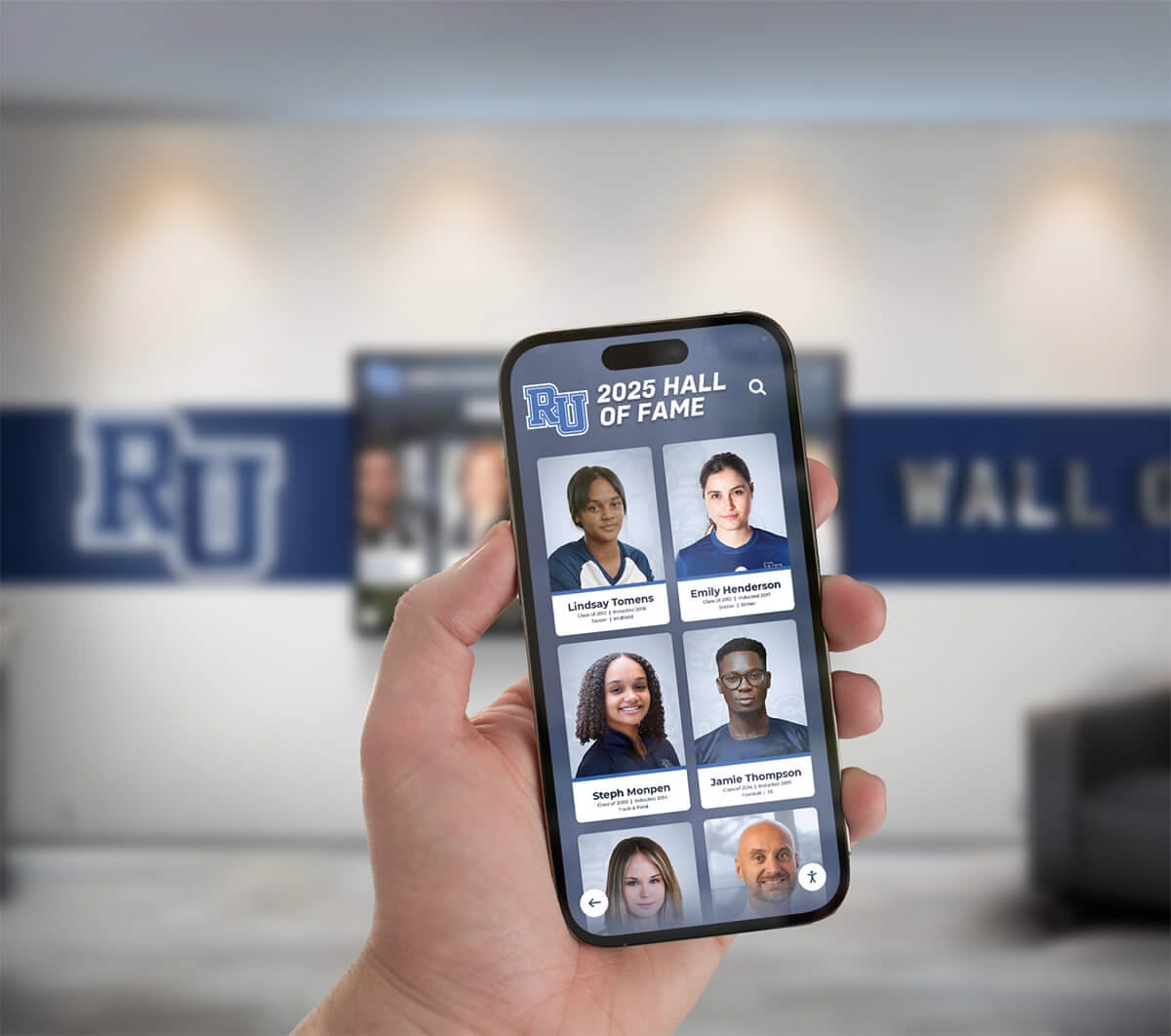
Data Collection and Profile Development
Once distinguished alumni are identified, systematic data collection ensures comprehensive, accurate profiles worthy of public recognition.
Essential Profile Information:
Basic Biographical Data: Full name (including maiden names and preferred names), graduation year and class information, current city and state of residence, contact information (when available and with permission).
Educational Background: Colleges and universities attended, degrees earned and fields of study, honors and academic achievements, relevant certifications and credentials.
Professional Achievements: Current position and organization, career progression and major roles held, significant accomplishments and contributions, awards and recognition received, innovations or notable projects.
High School Connection: Memorable experiences and influential teachers, athletic, academic, or extracurricular participation, high school achievements and honors, how their high school experience shaped their path, advice for current students.
Data Gathering Methods: Effective profile development combines multiple approaches including direct outreach to alumni via email or phone requesting information and photos, media research compiling published articles and interviews, professional biography mining from company websites and LinkedIn profiles, interview sessions (in-person, phone, or video) for detailed storytelling, and family outreach when alumni are deceased or difficult to contact directly.
Modern digital recognition platforms provide intuitive content management systems that streamline profile creation and ensure consistent presentation across hundreds or thousands of alumni profiles.
Display and Showcase Strategies
How you present your distinguished alumni network dramatically impacts its effectiveness in inspiring students and building community pride. Modern schools combine traditional and digital approaches to maximize visibility and engagement.
Traditional Physical Recognition
Classic recognition formats maintain symbolic value and create tangible presence throughout school facilities:
Wall Displays and Plaques: Dedicated hallways or common areas featuring engraved plaques with alumni names, graduation years, and major achievements provide permanent recognition that honors tradition. Traditional displays work best for highest-tier recognition like hall of fame inductees, professional athletes, and exceptional achievers.
Trophy Cases and Memorabilia: Physical cases can showcase three-dimensional items including championship trophies, signed memorabilia, awards, photos, and artifacts donated by distinguished alumni. These tactile displays create powerful connections to alumni achievements.
Athletic Recognition: Sports-specific displays in gymnasiums and athletic facilities celebrate athletic alumni through jersey retirement displays, record boards featuring top performers, championship team photos, and all-time great athlete recognition.
Limitations of Physical-Only Recognition: While traditional displays have symbolic value, they face significant constraints including limited space requiring difficult choices about who to recognize, high per-person costs for quality engraved plaques ($150-$400 each), inability to showcase detailed biographical information and multimedia, difficulty updating as careers progress and new alumni achieve distinction, and geographic limitation to on-campus visitors only.
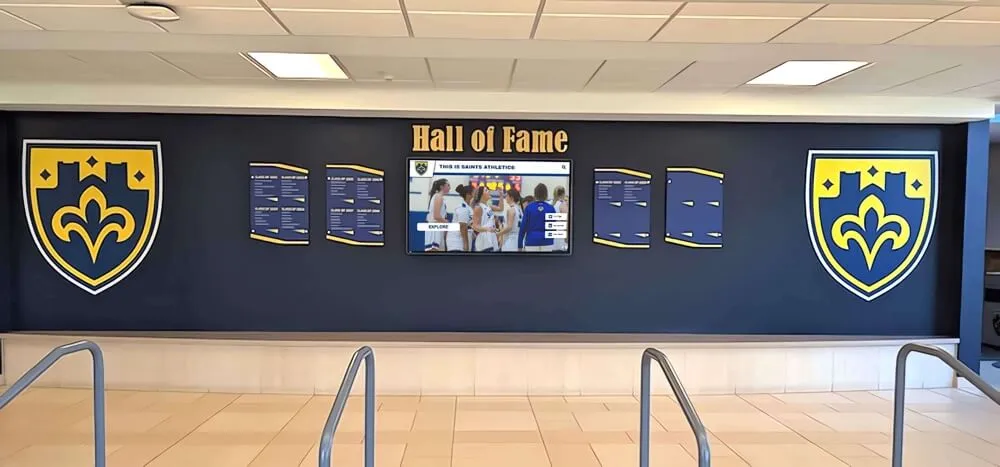
Digital Recognition Systems
Modern digital recognition technology addresses every limitation of traditional displays while introducing capabilities impossible with physical-only systems:
Digital Display Advantages:
- Unlimited Capacity: Recognize thousands of alumni without space constraints
- Rich Multimedia: Include photos, videos, career histories, and personal messages
- Easy Updates: Add new alumni and update profiles in minutes, not months
- Interactive Exploration: Search by name, graduation year, career field, or achievement type
- Remote Access: Web-based systems accessible worldwide, not just on campus
- Cost Efficiency: Lower long-term costs compared to repeated physical updates
Implementation Approaches:
- Lobby touchscreen kiosks for interactive exploration
- Large-format digital displays cycling through featured alumni
- Web-accessible databases with detailed profiles
- Mobile-friendly platforms for smartphone access
- QR codes linking physical spaces to digital content
- Social media integration for sharing capabilities
Solutions like interactive touchscreen displays enable schools to create comprehensive alumni recognition programs that scale infinitely while maintaining professional presentation and ease of management.
Hybrid Approaches for Maximum Impact
Many successful schools implement hybrid strategies combining selective traditional recognition with comprehensive digital systems:
- Reserve traditional plaques for hall of fame inductees and retired jerseys
- Use digital displays for comprehensive alumni databases and detailed profiles
- Implement QR codes on physical displays linking to extended digital content
- Maintain traditional aesthetic in historic buildings while adding digital capability
- Create “featured alumni” rotations on digital displays highlighting different graduates monthly
This balanced approach honors tradition while embracing modern capabilities that resonate with digitally-native current students. For guidance on effective hybrid implementation, explore resources on alumni recognition walls and strategic display planning.
Organizing Alumni Networks by Category
Effective databases organize alumni in intuitive ways that facilitate discovery and exploration based on what visitors find most interesting or relevant.
Organization by Career Field
Career field organization helps students explore alumni working in fields that interest them:
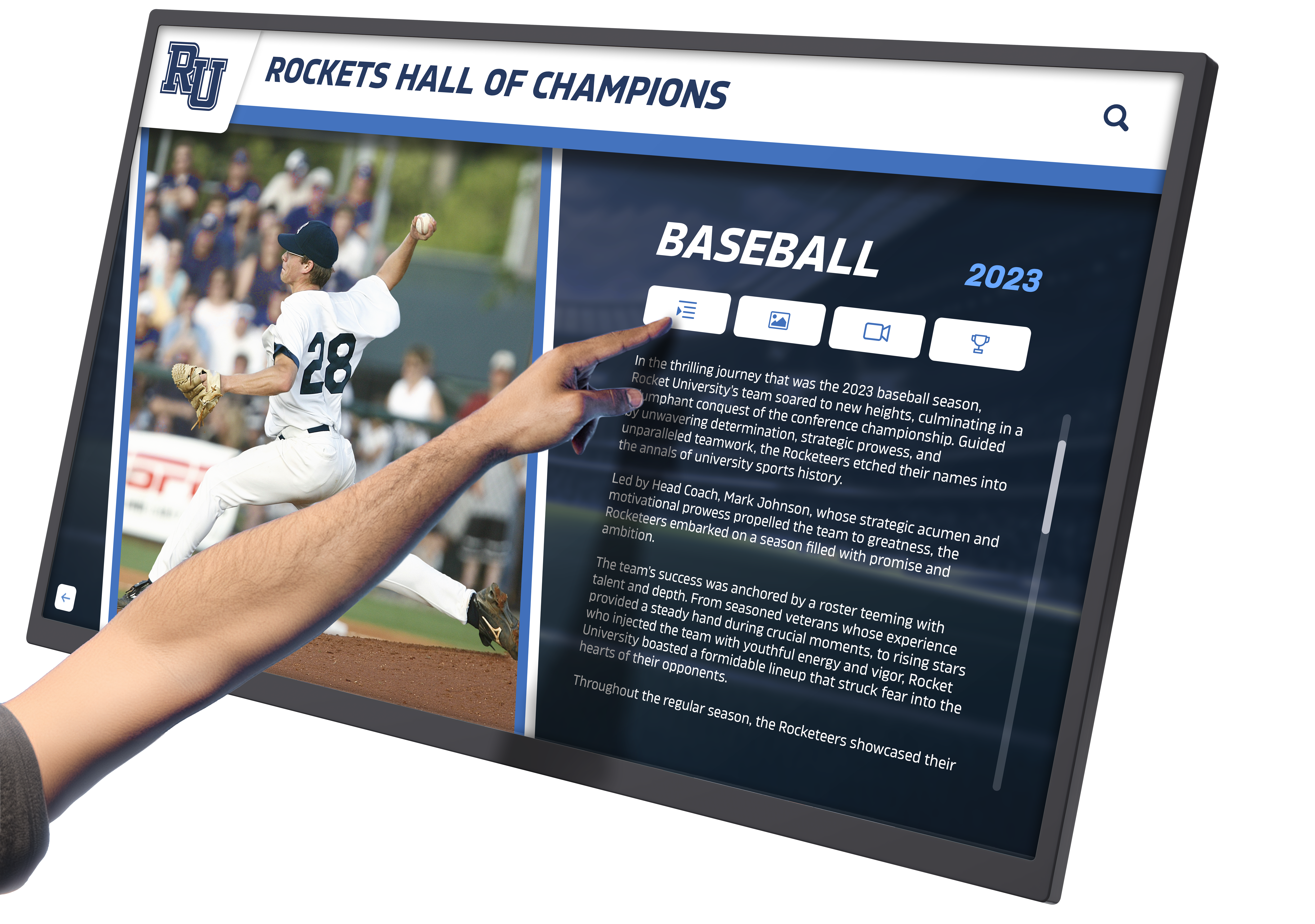
Career Field Categories:
- Athletics and Professional Sports
- Business and Entrepreneurship
- Medicine and Healthcare
- Education and Academia
- Law and Public Policy
- Arts, Entertainment, and Media
- Science, Technology, and Engineering
- Military and Public Service
- Nonprofit and Social Impact
Each category should include subcategories for specificity. For example, Medicine and Healthcare might subdivide into physicians by specialty, nursing and advanced practice, healthcare administration, medical research, and public health.
Organization by Achievement Level
Tiered recognition systems acknowledge both exceptional and notable achievements:
Tier Structure Example:
Hall of Fame Tier: The most exceptional alumni representing the pinnacle of achievement—professional athletes, Fortune 500 executives, nationally recognized leaders in their fields, major philanthropists and donors.
Distinguished Achievement Tier: Alumni with significant accomplishments including successful entrepreneurs and business owners, respected physicians and healthcare leaders, accomplished educators and administrators, community leaders and elected officials.
Notable Achievement Tier: Alumni demonstrating meaningful success and contribution—college scholarship athletes, established professionals in various fields, community volunteers and civic contributors, professionals making positive local impact.
Tiered systems prevent programs from feeling exclusionary by recognizing broader achievement while still celebrating the truly exceptional. This inclusive approach ensures more alumni receive recognition while maintaining meaningful standards.
Organization by Decade and Era
Chronological organization helps alumni find classmates and enables students to explore how alumni careers evolved across different time periods:
- Group alumni by graduation decade (1950s, 1960s, 1970s, etc.)
- Create special “legacy” categories for historical alumni
- Feature “then and now” content showing career progression over time
- Highlight how alumni achievements reflect changing times and opportunities
- Connect alumni across generations who worked in similar fields
Digital systems with robust search functionality can accommodate multiple organizational schemes simultaneously, allowing visitors to browse by career field, achievement level, or graduation decade based on their interests.
Content Creation Best Practices
The quality of your alumni profiles determines whether your network inspires students or simply lists names. Compelling content tells stories that engage and motivate.
Writing Engaging Alumni Profiles
Effective profiles balance professional accomplishment with personal narrative and school connection:
Story Arc Structure: Begin with current achievements to establish credibility, flashback to high school experiences and foundation, trace career progression and pivotal decisions, highlight major accomplishments with specific details, conclude with advice or reflections for current students.
Writing Principles:
- Use active voice and dynamic language
- Include specific examples over vague praise
- Quote alumni directly when possible
- Connect achievements to high school experiences
- Make accomplishments understandable to general audiences
- Balance professional success with character and values
- Include unexpected details that humanize subjects
Content to Avoid:
- Generic platitudes and cliches
- Jargon without explanation
- Excessive focus on titles without context
- Unverified claims or exaggerations
- Dated information that isn’t current
- Focus solely on achievement without story
- Content that reads like a resume
Example Profile Excerpt: “Dr. Jennifer Martinez ‘98 never forgot the moment her high school biology teacher, Mrs. Harrison, showed her class a video about open-heart surgery. ‘I was simultaneously terrified and fascinated,’ Jennifer recalls. ‘That’s when I knew.’ Today, Dr. Martinez serves as Chief of Cardiology at Memorial Hospital, where she’s pioneered minimally invasive procedures that have reduced recovery times by 40% and improved patient outcomes significantly. Her journey from AP Biology to leading a major cardiology department included…”
This opening establishes current achievement, connects to high school experience, includes specific impact data, and creates human interest that draws readers into the full story. Understanding effective student recognition strategies provides frameworks for compelling profile development.
Multimedia Content Development
Modern recognition systems support rich media that brings alumni stories to life beyond text alone:

Video Content: Professional video interviews with alumni discussing their careers (2-5 minutes), short highlight reels of athletic alumni performances, message videos where alumni offer advice to current students, documentary-style mini-profiles telling complete career stories, testimonials from colleagues or community members about alumni impact.
Photography: Professional headshots showing current appearance, high school yearbook photos for then-and-now comparisons, action shots of alumni in their professional environments, candid photos from campus visits or reunions, historical photos documenting career milestones and achievements.
Interactive Elements: Clickable career timelines showing progression over time, photo galleries with multiple images from different career stages, audio clips of speeches or interviews, links to published work, media coverage, or professional profiles, embedded social media content showing current activities.
Quality multimedia production significantly increases engagement with recognition displays. Students spend considerably more time exploring video-enhanced profiles compared to text-only content, making the investment in multimedia development worthwhile for maximum inspirational impact.
Leveraging Alumni Networks for Student Benefit
Distinguished alumni networks deliver maximum value when actively integrated into student experience rather than existing as passive displays.
Career Exploration and Mentorship Programs
Alumni networks provide natural foundations for career development programming:
Career Panels and Speaker Series: Host alumni panels organized by career field where students can hear directly from professionals, bring back distinguished alumni as keynote speakers for assemblies, create alumni speaker series with regular presentations throughout the year, organize career fairs featuring alumni from diverse industries.
Mentorship Connections: Facilitate formal mentorship programs pairing students with alumni in fields of interest, create networking opportunities during alumni visits and reunions, develop online mentorship platforms connecting students and alumni remotely, and encourage alumni to provide internship and job shadowing opportunities.
Virtual Career Exploration: For alumni who can’t return to campus frequently, leverage technology with virtual Q&A sessions via video conference, recorded “day in the life” videos showing alumni at work, online mentorship through email or messaging platforms, and social media connections following alumni professional journeys.
Platforms like Rocket Alumni Solutions often integrate features specifically designed to facilitate student-alumni connections, enabling schools to build mentorship programs directly into their recognition systems.
Integration with Curriculum and Instruction
Teachers can leverage alumni networks as educational resources across subject areas:
English/Language Arts: Research projects investigating alumni career paths and writing profiles, persuasive essays examining what contributes to success, interview skills practice through alumni conversations, and presentation skills developed through alumni research presentations.
Social Studies: Case studies examining how alumni careers reflect historical context, economics lessons using alumni business ventures as examples, civics instruction featuring alumni in public service and policy, and geography connections to where alumni live and work globally.
Career and Technical Education: Real-world examples of career pathways in various trades and professions, industry insights from alumni working in specific fields, guidance on educational requirements for different career paths, and mentorship from alumni in CTE-related careers.
Guidance and Counseling: College exploration using alumni educational paths as examples, career assessment activities comparing interests to alumni career fields, goal-setting exercises inspired by alumni achievement stories, and resilience education learning from alumni who overcame challenges.
This curricular integration transforms alumni recognition from decorative displays into active educational tools that enhance learning across disciplines.
Inspiration and Goal-Setting Initiatives
Strategic programming helps students connect personally with alumni achievements:
Goal-Setting Campaigns: “I will be the next…” campaigns where students identify alumni to emulate, vision board activities featuring alumni who achieved similar goals, college and career planning sessions highlighting diverse alumni educational paths, and “pathway planning” showing steps alumni took from high school to career success.
Recognition of Current Student Achievement: Connect current student recognition to alumni tradition by featuring “future distinguished alumni” displays showcasing current high achievers, celebrating students who demonstrate similar qualities to celebrated alumni, creating “emerging leader” recognition for students showing exceptional promise, and documenting current student achievements for future alumni database inclusion.
Understanding how to showcase student accomplishments creates connections between current students and the alumni they’ll eventually join in your distinguished graduate network.
Technology Platforms and Solutions
Selecting appropriate technology infrastructure ensures your distinguished alumni network remains sustainable, accessible, and engaging long-term.
Digital Display Systems
Interactive displays serve as focal points for on-campus alumni recognition:
Touchscreen Kiosks: Freestanding or wall-mounted touchscreens (43"-75" typically) placed in high-traffic areas like main lobbies, cafeterias, or athletic facilities enable students, visitors, and alumni to explore profiles through intuitive touch interfaces with search functionality, category browsing, and multimedia playback capabilities.
Digital Signage Walls: Large-format displays (65"-100+") create impressive visual impact in prominent locations, cycling through featured alumni profiles, highlighting recent additions to the database, showcasing accomplishments aligned with current school events, and providing wayfinding to more detailed information.
Implementation Considerations: Choose commercial-grade displays rated for continuous operation (not consumer TVs), ensure appropriate viewing distance for screen size (general rule: distance = diagonal × 1.5), plan for reliable power and network connectivity, consider ADA-compliant mounting heights, and budget for both hardware and ongoing software/content management.
Solutions specifically designed for educational recognition like interactive hall of fame displays provide turnkey systems with pre-built interfaces optimized for alumni showcase applications.
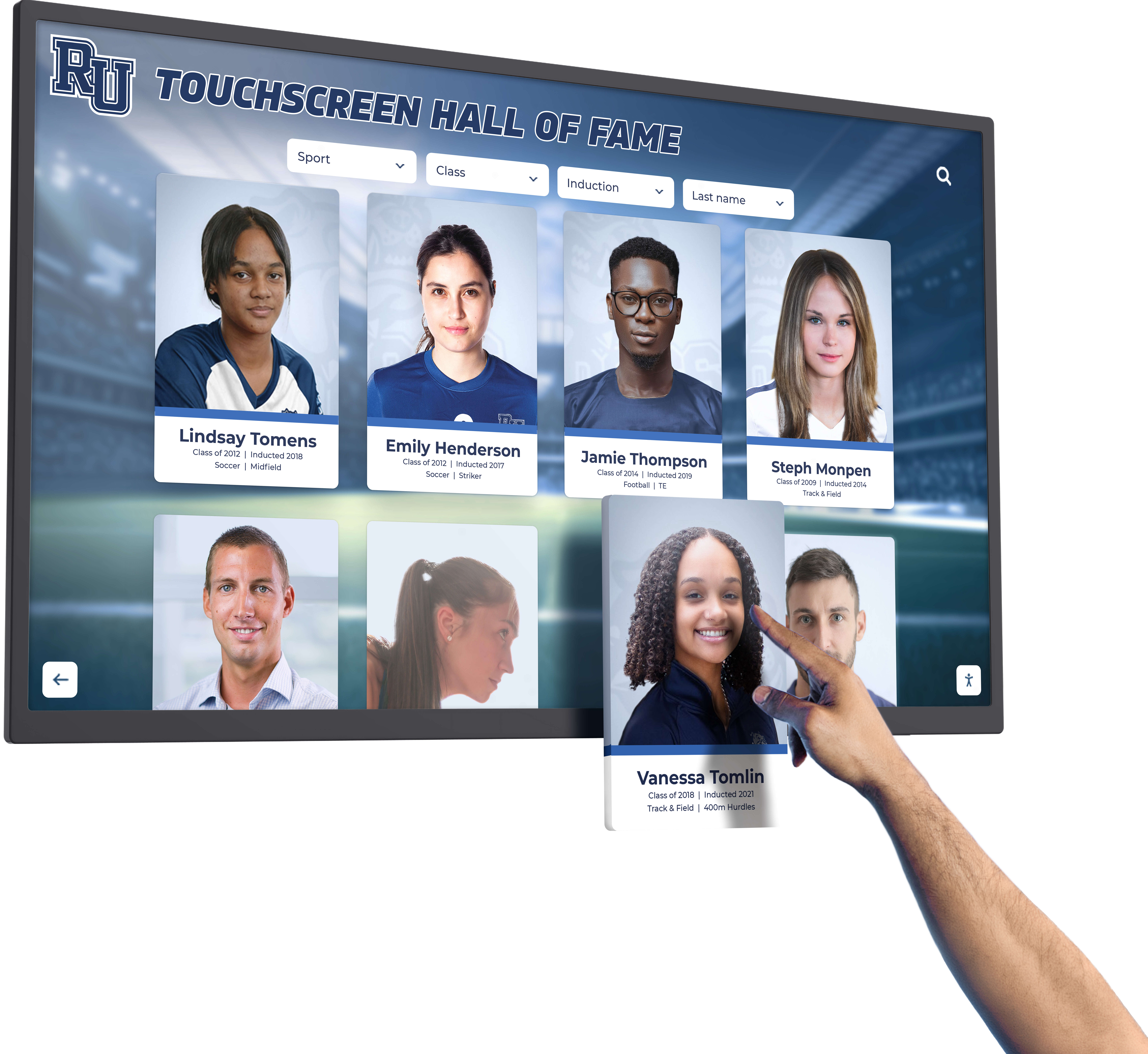
Web-Based Alumni Databases
Online databases extend alumni recognition beyond physical campus boundaries:
Essential Features: Robust search functionality by name, year, career field, or keyword; detailed profile pages with photos, biographies, and multimedia; mobile-responsive design working seamlessly on all devices; social sharing capabilities for easy distribution; content management system for non-technical staff updates; and integration with existing school websites and social media.
Platform Options: Dedicated alumni network platforms built specifically for educational institutions, custom development creating unique branded experiences, integration with existing school website platforms and content management systems, and hybrid approaches combining third-party platforms with school-hosted content.
Web-based systems allow alumni worldwide to explore recognition from anywhere, enable families to share profiles across social networks, provide resources for college and career counseling programs, and create touchpoints for fundraising and advancement initiatives.
Content Management and Maintenance
Sustainable systems require intuitive tools for ongoing content management:
User-Friendly Administration: Cloud-based content management accessible from anywhere, template-based profile creation standardizing presentation, bulk upload capabilities for adding multiple alumni efficiently, workflow management for content approval processes, and role-based permissions ensuring appropriate access levels.
Mobile Content Creation: Mobile apps or responsive interfaces enabling content updates from smartphones and tablets, photo upload directly from mobile devices during events, quick profile edits and corrections from anywhere, and real-time updates visible immediately on displays and websites.
Modern platforms prioritize ease of use for non-technical administrators, recognizing that sustainable programs require tools that school staff can confidently manage without IT department dependence for routine updates.
Maintaining and Growing Your Network
Initial launch represents just the beginning. Long-term success requires ongoing maintenance and strategic growth.
Regular Update Protocols
Establish systematic processes for keeping content current:
Annual Review Cycles: Schedule comprehensive reviews each year during summer months when school is less busy, verify that all profile information remains accurate and current, update photos that have become outdated, add recent achievements and career developments for living alumni, and remove or correct any errors discovered since last review.
New Achievement Monitoring: Set up Google Alerts and media monitoring for alumni names, follow distinguished alumni on professional networks like LinkedIn, monitor industry publications and award announcements, maintain relationships with alumni who share updates about themselves and classmates, and encourage community members to report notable alumni achievements.
Systematic Addition Process: Create regular nomination and induction cycles (annually or semi-annually), establish clear criteria for inclusion at different recognition tiers, implement vetting processes verifying achievements before public recognition, develop efficient workflows for new profile creation, and celebrate new additions through announcements and events.
Graduation Class Outreach: Target reunion years (5th, 10th, 25th, 50th) for intensive class research, distribute surveys and questionnaires collecting career information, host reunion events highlighting distinguished class members, appoint class ambassadors who maintain ongoing connections, and use reunion momentum to gather photos and biographical details.
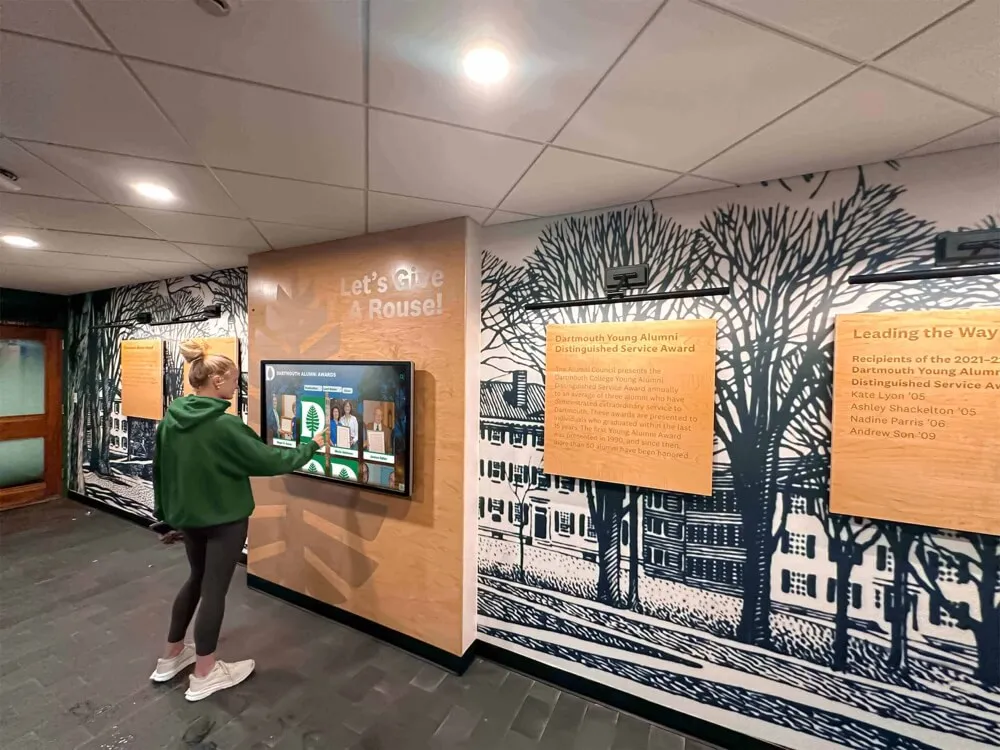
Expanding Content Depth
Continuously enhance profile quality and comprehensiveness:
Legacy Documentation: Prioritize interviews with older alumni before stories are lost, record oral histories capturing important school history, digitize historical photos and documents from personal collections, and connect with alumni families after alumni pass away to preserve their legacies.
Multimedia Expansion: Add video content to high-profile alumni lacking video currently, update older videos with new interviews showing career progression, create photo galleries showing alumni careers over time, and develop documentary-style mini-profiles for most distinguished graduates.
Relationship Building: Send periodic updates to recognized alumni about their profiles, involve alumni in content review and accuracy verification, invite alumni to contribute directly to their profiles, and maintain ongoing communication that keeps alumni engaged with the school.
Comprehensive systems like digital hall of fame platforms provide structured workflows supporting systematic content maintenance and expansion over time.
Measuring Impact and Success
Assessing your distinguished alumni network’s effectiveness ensures continued investment and guides strategic improvements.
Engagement Metrics
For digital systems, built-in analytics reveal usage patterns and popular content:
Quantitative Measures: Track total unique visitors and sessions exploring alumni content, average time spent viewing profiles and browsing categories, most-viewed alumni profiles and career fields, search terms revealing what visitors seek, and comparative engagement across different content types (text vs. video vs. photos).
User Behavior Patterns: Identify peak usage times for displays and website traffic, analyze navigation paths showing how visitors explore content, measure social sharing frequency for different alumni profiles, track mobile vs. desktop access patterns, and monitor return visitor rates indicating sustained interest.
Content Performance: Determine which alumni profiles generate most engagement, identify which career fields attract greatest interest, assess effectiveness of different multimedia elements, and evaluate which organizational approaches (field vs. decade vs. achievement) visitors prefer.
Qualitative Feedback
Beyond numbers, gather direct input from stakeholders:
Student Surveys and Focus Groups: Assess student awareness of distinguished alumni recognition, measure whether alumni stories influence college and career aspirations, identify which alumni students find most inspiring and why, gather suggestions for additional alumni to recognize, and evaluate whether recognition helps students envision their own future possibilities.
Alumni Feedback: Survey recognized alumni about their experience and satisfaction, ask whether recognition increased their engagement with the school, determine interest in mentorship or speaking opportunities, and collect updates about their careers and lives for profile enhancements.
Parent and Community Response: Gauge family awareness of distinguished alumni programs, assess whether alumni recognition influences family opinion of the school, measure community pride in graduate achievements, and evaluate impact on family decisions to enroll or remain in the school.
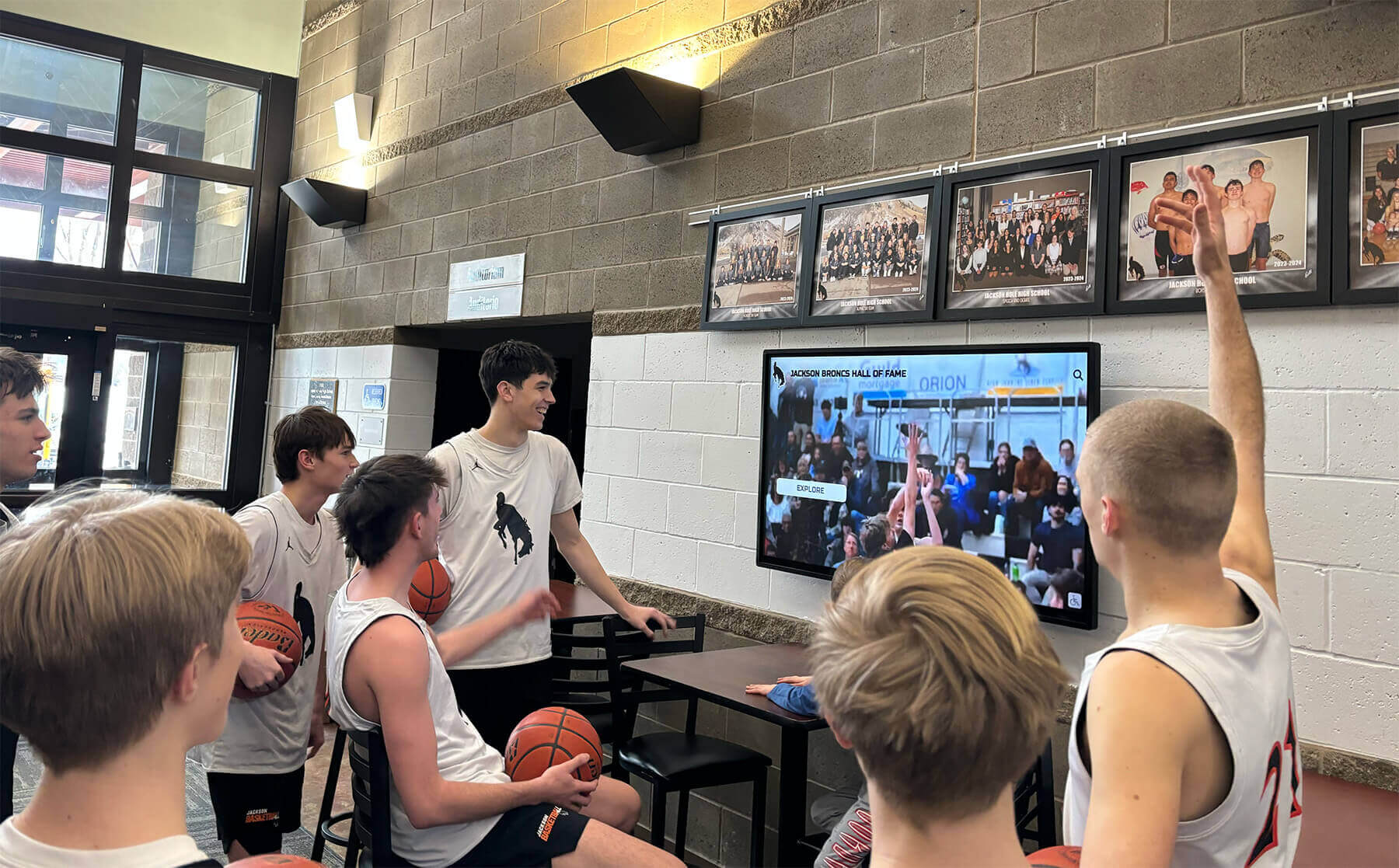
Outcome Indicators
Connect alumni recognition to broader school goals:
Student Inspiration Impact: Track whether college aspiration rates increase following alumni network launch, monitor career interest diversity reflecting broader alumni achievement categories, measure participation in career exploration and mentorship programs, and assess student goal-setting ambition and specificity.
Community Engagement: Measure increases in alumni event attendance and engagement, track improvements in alumni giving and philanthropic support, assess growth in volunteer alumni participation, and gauge strengthening of alumni association membership and activity.
Recruitment and Retention: Evaluate whether prospective family tours mention alumni recognition, assess impact on family enrollment decisions in choice environments, measure current family satisfaction citing graduate success, and track whether transfer rates decrease as school pride strengthens.
Strategic measurement enables data-driven optimization of your alumni network, ensuring resources focus on highest-impact activities and content.
Overcoming Common Challenges
Schools implementing distinguished alumni networks encounter predictable obstacles that proven strategies address effectively.
Limited Historical Information
Many schools struggle with incomplete historical records, particularly for alumni from decades past:
Solutions: Partner with local historical societies and libraries for archived materials, engage older alumni and community members as research volunteers, utilize yearbook digitization and crowd-sourced identification, leverage genealogy websites and ancestry research by alumni families, and accept that some information may never be recovered while documenting what you can.
Prioritization Strategies: Begin with recent decades where information is most accessible, focus initial efforts on highest-profile alumni whose achievements are documented publicly, build momentum with impressive initial content that justifies investment in deeper historical research, and expand systematically backward through time as resources and capacity allow.
Privacy and Permission Concerns
Not all alumni want public recognition or may have concerns about privacy:
Best Practices: Establish clear policies about consent and opt-out procedures, attempt to contact alumni before including them (when possible), honor all requests to be excluded without exception, use only publicly available information unless alumni provide permission for private details, and provide mechanisms for alumni to review and approve their profiles.
Public Figure Exception: Alumni whose achievements are extensively documented in public media may be recognized based solely on public information, though attempting courtesy notification remains respectful practice even when not legally required.
Sensitive Information: Avoid including contact information without explicit permission, be mindful of privacy for alumni in sensitive professions (law enforcement, intelligence, witness protection), respect alumni requests to minimize rather than highlight their profiles, and consider anonymous recognition options for alumni who want to give back privately.
Resource Constraints
Comprehensive alumni networks require significant initial investment and ongoing maintenance:
Phased Implementation: Launch with pilot programs recognizing one category or decade, demonstrate success and impact justifying expanded investment, grow systematically as resources allow rather than attempting everything immediately, and prioritize highest-impact alumni and categories in early phases.
Leveraging Volunteers: Engage alumni association members in research and outreach, recruit student clubs for specific research projects, partner with parent volunteers for data entry and organization, and involve retirees with school connections who have time to contribute.
Technology Solutions: Invest in platforms like Rocket Alumni Solutions that provide efficient content management reducing ongoing administrative burden, leverage digital displays that eliminate recurring physical production costs, and implement systems that scale efficiently from hundreds to thousands of profiles without proportional resource increases.
Integration with Fundraising and Development
Distinguished alumni networks naturally support advancement initiatives when implemented strategically:
Grateful Graduate Engagement
Recognition often rekindling emotional connections that translate into philanthropic support:
Recognition-to-Giving Pipeline: Notify alumni when they’re selected for recognition, creating positive touchpoint; invite honored alumni to special recognition events, building community; provide opportunities for recognized alumni to “give back” through time, expertise, or financial support; and connect recognition to specific giving opportunities aligned with alumni interests.
Stewardship Through Recognition: Major donors typically receive prominent recognition in alumni databases, scholarship creators are honored alongside recipients who succeed, naming opportunity donors are celebrated in digital and traditional displays, and volunteer leaders receive appreciation through distinguished service categories.
Alumni Networking and Connection
Strong networks increase likelihood of philanthropy:
Reunion Leverage: Feature distinguished class members prominently during reunions, create giving challenges highlighting class representation in alumni recognition, use recognition displays as gathering points during reunion events, and encourage honored alumni to speak about giving back during celebrations.
Career Field Affinity Groups: Organize alumni networking events by professional field, facilitate mentorship programs connecting students with alumni, create industry-specific giving societies, and develop career-focused scholarship programs supported by alumni in those fields.
Effective integration of recognition and development respects that not all recognition should be transactional while acknowledging that gratitude and emotional connection naturally encourage generosity. Resources on parent and family engagement provide frameworks for building supportive school communities.
Future Trends in Alumni Recognition
Distinguished alumni networks continue evolving with emerging technologies and changing expectations:
Artificial Intelligence and Personalization
AI-powered systems will enhance discovery and personalization:
- Recommendation engines suggesting alumni profiles based on student interests and career aspirations
- Automated content summarization making lengthy profiles scannable
- Natural language search enabling conversational queries
- Predictive analytics identifying students most likely to benefit from specific alumni connections
- Automated monitoring discovering new alumni achievements through web scanning
Enhanced Multimedia and Immersion
Recognition will increasingly leverage advanced media:
- Virtual reality experiences exploring alumni workplaces and career environments
- Augmented reality overlays bringing historical alumni to life in campus spaces
- Interactive 360-degree video allowing students to experience alumni professional settings
- Livestream integration featuring real-time alumni participation in school events
- Podcast-style long-form interviews providing deep career exploration
Social and Collaborative Features
Modern platforms will emphasize community and connection:
- Alumni-to-student messaging enabling direct mentorship connections
- Collaborative storytelling where multiple alumni contribute to shared narratives
- Student reflection features allowing students to document how alumni inspire them
- Alumni networking tools facilitating professional connections between graduates
- Crowdsourced content where alumni contribute directly to database expansion
Schools investing in flexible, updatable digital platforms position themselves to adopt emerging capabilities as they mature without replacing entire systems. Understanding digital recognition trends helps schools make forward-looking technology decisions.
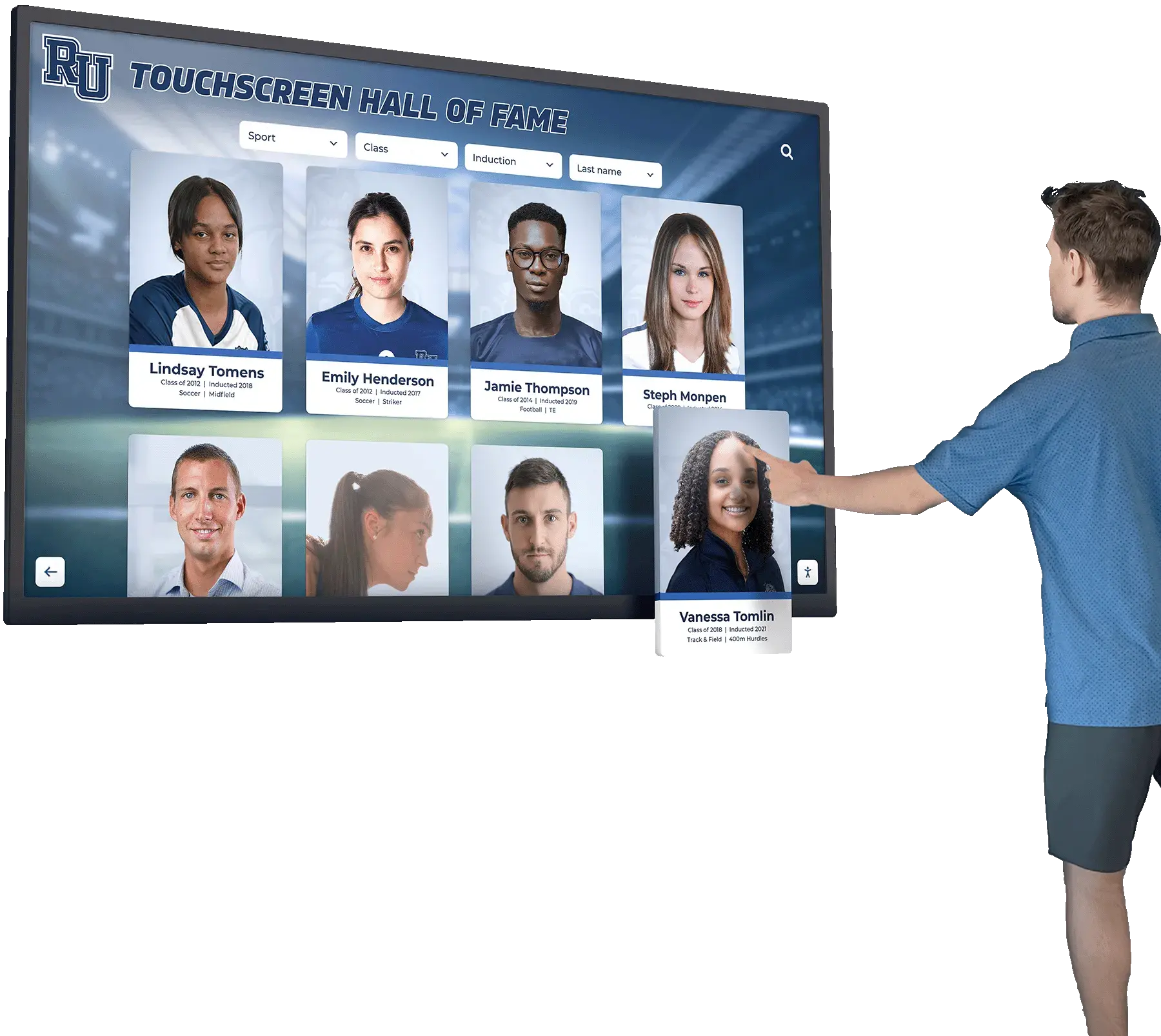
Conclusion: Building Legacy Through Recognition
Distinguished alumni networks represent investments in multiple dimensions of school excellence simultaneously. By systematically identifying, documenting, and showcasing graduates who achieved success across diverse fields—from professional athletes and Fortune 500 CEOs to medical professionals and community leaders—schools create powerful tools that inspire current students, strengthen community pride, and preserve institutional legacy.
The most successful programs share common characteristics: comprehensive rather than selective recognition celebrating diverse achievement, compelling storytelling that goes beyond listing titles and positions, accessible presentation through both traditional and digital formats, active integration into student programming and curriculum, and sustained commitment to maintenance and growth over time.
Whether you’re launching a new distinguished alumni network or enhancing an existing program, remember that every recognized alumnus represents both an individual honor and a collective institutional achievement. Each profile tells current students that success is possible, shows families that their school develops exceptional graduates, and demonstrates to communities that their school makes lasting impact on the world.
Modern recognition technology, particularly comprehensive digital platforms, enables schools of all sizes to build and showcase alumni networks that rival much larger institutions. The barriers to creating impressive, comprehensive alumni recognition have never been lower, making this the ideal time for schools to invest in systems that will honor graduates and inspire students for decades to come.
Start where you are. Begin with your most distinguished graduates and most accessible information. Build momentum through initial success. Expand systematically as resources allow. Most importantly, remember that the goal isn’t perfection—it’s creating meaningful recognition that celebrates achievement, inspires aspiration, and strengthens the bonds connecting generations of students who share your school’s educational experience.
Your distinguished alumni are out there making remarkable contributions to their communities and professions. They deserve recognition. Your current students deserve inspiration. Your school deserves celebration. A comprehensive, well-executed alumni network delivers all three, creating lasting value that compounds year after year as new graduates join the distinguished ranks of those who came before.
Ready to Showcase Your Distinguished Alumni?
Discover how modern digital recognition systems can help you build comprehensive alumni networks that celebrate every dimension of graduate success. Solutions like Rocket Alumni Solutions provide everything needed to transform scattered alumni information into inspiring recognition programs that motivate students, build community pride, and honor the remarkable graduates your school has produced across decades of educational excellence.
